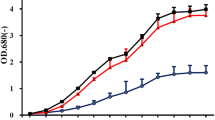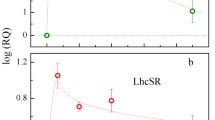Abstract
To find out how microalgae cope with heat stress, the small vegetative cells of a synchronous Scenedesmus vacuolatus culture were subjected to heat treatment and then cultured under continuous illumination. The heat-treated cells were found first to enter a degenerative intermediate stage with low cellular activities almost right after the start of the cultivation, which was then followed by a revival. The changes in physiological activities and morphology of the treated cells throughout the whole period of regeneration were explored. The variations in cellular DNA content and protein composition were also investigated. Stressed cells at the end of the degeneration stage were completely bleached and were also characterized by condensed but undegraded chromatin, partially disintegrated chloroplasts but with the thylakoid membrane system retained, partially operating mitochondria, intact plasma membranes, and a dramatically changed profile of cellular proteins. All of our data indicate they were still alive but in a different physiological state than the control cells. Recovery started with regeneration of mitochondrial cristae and redispersion of chromatins. These were followed by regreening and resuscitation of chloroplasts, which often started from one part of a thylakoid membrane system and then spread out. This study provided a unicellular model for studying how plant cells react to a period of stress and recover.






Similar content being viewed by others
Abbreviations
- 2DE:
-
Two-dimensional gel electrophoresis
- DAPI:
-
4′-6-Diamidino-2-phenylindole
- MTT:
-
3-[4,5-Dimethylthiazol-2-yl]-2,5-diphenyl-tetrazolium bromide
- PBS:
-
Phosphate buffered saline
- ROS:
-
Reactive oxygen species
- TEM:
-
Transmission electron microscopy
References
Affenzeller MJ, Darehshouri A, Andosch A, Lütz C, Lütz-Meindl U (2009) PCD and autophagy in the unicellular green alga Micrasterias denticulata. Autophagy 5:854–855
Allakhverdiev SI, Kreslavski VD, Klimov VV, Los DA, Carpentier R, Mohanty P (2008) Heat stress: an overview of molecular responses in photosynthesis. Photosynth Res 98:541–550
Becker EW (1994) Measurement of algal growth. In: Microalgae: biotechnology and Microbiology. Cambridge University Press, Cambridge, pp 56–62
Berry JA, Björkman O (1980) Photosynthetic response and adaptation to temperature in higher plants. Annu Rev Plant Physiol 31:491–543
Bumbulis MJ, Balog BM (2013) UV-C exposure induces an apoptosis-like process in Euglena gracilis. ISRN Cell Biol. doi:10.1155/2013/869216
Cakmak I (2000) Possible roles of zinc in protecting plant cells from damage by reactive oxygen species. New Phytol 146:185–205
Cameron RE, Blank GB (1966) Desert algae: soil crusts and diaphanous substrata as algal habitats. In: Technical Report 32-971. Jet Propulsion Laboratory, California Institute of Technology, Pasadena, pp 1–41
Chen PC, Lai CL (1996) Physiological adaptation during cell dehydration and rewetting of a newly-isolated Chlorella species. Physiol Plant 96:453–457
Chen PC, Lorenzen H (1986) Changes in the productivity and nuclear divisions in synchronous Chlorella and circadian rhythm. Plant Cell Physiol 27:1423–1427
Choi KM, Lee MY (2012) Differential protein expression associated with heat stress in Antarctic microalga. BioChip J 6:271–279
González A, Steffen KL, Lynch JP (1998) Light and excess manganese, implications for oxidative stress in common bean. Plant Physiol 118:493–504
Grossmann K, Kwiatkowski J, Tresch S (2001) Auxin herbicides induce H2O2 overproduction and tissue damage in cleavers (Galium aparine L.). J Exp Bot 52:1811–1816
Houot V, Etienne P, Petitot AS, Barbier S, Blein JP, Suty L (2001) Hydrogen peroxide induces programmed cell death features in cultured tobacco BY-2 cells, in a dose-dependent manner. J Exp Bot 52:1721–1730
Ikegawa H, Yamamoto Y, Matsumoto H (1998) Cell death caused by a combination of aluminum and iron in cultured tobacco cells. Physiol Plant 104:474–478
Inada N, Sakai A, Kuroiwa H, Kuroiwa T (1998) Three-dimensional analysis of the senescence program in rice (Oryza sativa L.) coleoptiles—investigations by fluorescence microscopy and electron microscopy. Planta 205:153–164
Jiménez C, Capasso JM, Edelstein CL, Rivard CJ, Lucia S, Breusegem S, Berl T, Segovia M (2009) Different ways to die: cell death modes of the unicellular chlorophyte Dunaliella viridis exposed to various environmental stresses are mediated by the caspase-like activity DEVDase. J Exp Bot 60:815–828
Khanna-Chopra R (2012) Leaf senescence and abiotic stresses share reactive oxygen species-mediated chloroplast degradation. Protoplasma 249:469–481
Krupinska K (2007) Fate and activities of plastids during leaf senescence. In: Wise RR, Hoober JK (eds) The structure and function of plastids. Springer, Dordrecht, pp 433–449
Lee TC, Hsu BD (2013) Characterization of the decline and recovery of heat-treated Scenedesmus vacuolatus. Bot Stud. doi:10.1186/1999-3110-54-3
Matile P, Hörtensteiner S, Thomas H (1999) Chlorophyll degradation. Annu Rev Plant Physiol Plant Mol Biol 50:67–95
Moharikar S, D’Souza JS, Kulkarni AB, Rao BJ (2006) Apoptotic-like cell death pathway is induced in unicellular chlorophyte Chlamydomonas reinhardtii (Chlorophyceae) cells following UV radiation: detection and functional analyses. J Phycol 42:423–433
Mühlhaus T, Weiss J, Hemme D, Sommer F, Schroda M (2011) Quantitative shotgun proteomics using a uniform 15N-labeled standard to monitor proteome dynamics in time course experiments reveals new insights into the heat stress response of Chlamydomonas reinhardtii. Mol Cell Proteomics. doi:10.1074/mcp.M110.004739
Munné-Bosch S, Jubany-Marí T, Alegre L (2001) Drought-induced senescence is characterized by loss of antioxidant defences in chloroplasts. Plant Cell Environ 24:1319–1327
Öquist G, Huner NPA (2003) Photosynthesis of overwintering evergreen plants. Annu Rev Plant Biol 54:329–355
Schmollinger S, Schulz-Raffelt M, Strenkert D, Veyel D, Vallon O, Schroda M (2013) Dissecting the heat stress response in Chlamydomonas by pharmaceutical and RNAi approaches reveals conserved and novel aspects. Mol Plant 6:1795–1813
Segovia M, Berges JA (2009) Inhibition of caspase-like activities prevents appearance of reactive oxygen species and dark-induced apoptosis in the unicellular chlorophyte Dunaliella tertiolecta. J Phycol 45:1116–1126
Suzuki N, Mittler R (2006) Reactive oxygen species and temperature stresses: a delicate balance between signaling and destruction. Physiol Plant 126:45–51
van Doorn WG, Woltering EJ (2005) Many ways to exit? Cell death categories in plants. Trends Plant Sci 10:117–122
van Doorn WG, Beers EP, Dangl JL, Franklin-Tong VE, Gallois P, Hara-Nishimura I, Jones AM, Kawai-Yamada M, Lam E, Mundy J, Mur LA, Petersen M, Smertenko A, Taliansky M, van Breusegem F, Wolpert T, Woltering E, Zhivotovsky B, Bozhkov PV (2011) Morphological classification of plant cell deaths. Cell Death Differ 18:1241–1246
Yamane K, Rahman MS, Kawasaki M, Taniguchi M, Miyake H (2004) Pretreatment with antioxidants decreases the effects of salt stress on chloroplast ultrastructure in rice leaf segments (Oryza sativa L.). Plant Prod Sci 7:292–300
Yordanov IS, Dilova R, Petkova T, Pangelova V, Goltsev V, Zuss KH (1986) Mechanisms of the temperature damage and acclimation of the photosynthetic apparatus. Photobiochem Photobiophys 12:147–155
Zhang D, Koay ESC (2008) Analysis of laser capture microdissected cells by 2-dimensional gel electrophoresis. In: Vlahou A (ed) Clinical proteomics, methods and protocols. Humana Press, Totowa, pp 77–91
Zuppini A, Andreoli C, Baldan B (2007) Heat stress: an inducer of programmed cell death in Chlorella saccharophila. Plant Cell Physiol 48:1000–1009
Acknowledgments
This work was supported by the National Science Council of Taiwan [NSC 97-2311-B-007 -002].
Conflict of interest
The authors declare that they have no conflict of interest.
Author information
Authors and Affiliations
Corresponding author
Additional information
Handling Editor: Andreas Holzinger
Electronic supplementary material
Below is the link to the electronic supplementary material.
ESM 1
(DOC 82 kb)
Rights and permissions
About this article
Cite this article
Lee, TC., Hsu, BD. The reversible degeneration of heat-treated Scenedesmus vacuolatus under continuous light cultivation conditions. Protoplasma 251, 1201–1211 (2014). https://doi.org/10.1007/s00709-014-0627-y
Received:
Accepted:
Published:
Issue Date:
DOI: https://doi.org/10.1007/s00709-014-0627-y




